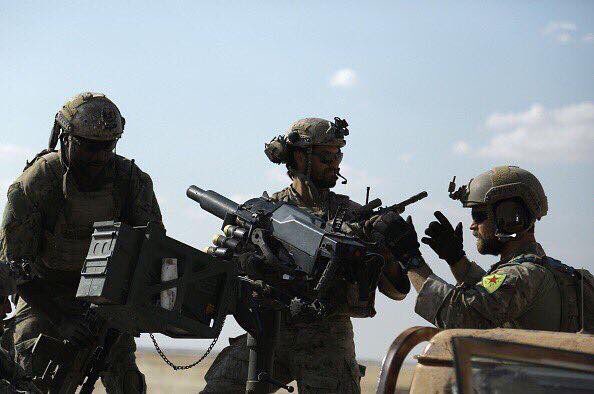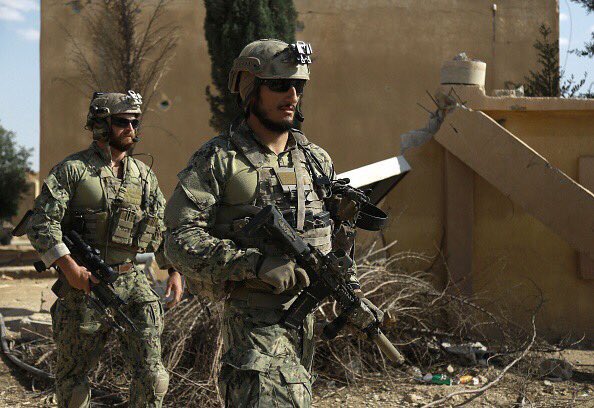
Just days after the U.S. military and an alliance of Kurdish and Arab groups announced the beginning of their offensive to retake Raqqa, the Islamic State’s de facto capital in Syria, images have emerged of what appear to be U.S. Special Operations forces fighting near the front lines.
The pictures, as distributed by Agence France Presse, indicate that the troops were identified as American by the group they are supporting, the Syrian Democratic Forces (SDF). The troops have all the hallmarks of America’s clandestine warriors: low profile helmets, a smattering of non-traditional small arms and camouflage patterns consistent with special warfare units. In one image a trio of U.S. forces are clustered around what appears to be an advanced Mk.47 automatic grenade launcher. The system, built by General Dynamics, is primarily used by Special Operations units and has not been widely sold outside the United States.
In one image, someone who appears to be an American is wearing a Kurdish People’s Protection Unit patch on his left arm. Known as the YPG, the Kurdish units form a large majority of the SDF and have been critical to almost all of the victories against the Islamic State in northern Syria.
The YPG has long been branded by the Turkish authorities as the Syrian arm of Turkey’s Kurdistan’s Workers Party, known as the PKK. The PKK is regarded as a terrorist group by the United States, but U.S. officials dispute the Turkish claim that the PKK and the YPG are one and the same. But the appearance of a YPG patch on a U.S. soldier’s arm will likely inflame tensions with Ankara as well as some Arab groups aligned against the Kurds, including components of U.S.-backed Syrian rebels.
When embedded with a partner country or ally, U.S. Special Operations forces often wear the patch or sometimes even the uniform of those they are supporting. Showing solidarity with allies is an essential component of one of Special Operation’s key missions, known as Foreign Internal Defense, or FID.
“They are basically on the front lines, backing up the local SDF forces with artillery and targeting assistance. It’s unclear how many there are,” said Wladimir Van Wilgenburg, a researcher based in the Kurdish northeast with the Iraq Institute for Strategic Studies. “They can be found on every front line, but in the northern Raqqa operation there is a much bigger concentration.”
Army Col. Steve Warren, a spokesman for the U.S.-led coalition fighting the Islamic State, confirmed in an email that U.S. forces are “providing advice and assistance to the Syrian Democratic Forces,” but would not go into further detail.
An original force of 50 special operators was bolstered by the arrival of an additional 250 troops in April. After the troops deployed, a U.S. official, who spoke on condition of anonymity in order to discuss military plans, said their primary focus would be to train more Arab forces in the Raqqa area, and bring them into the SDF.
U.S. Special Operations troops have been a linchpin for recent operations against the Islamic State in Syria and Iraq, but the Pentagon and White House insist that the troops are participating in a non-combat mission known as “train, advise and assist.” That means that the U.S. troops are often in a supporting role, providing fire support and coordinating airstrikes from behind the front lines, although in a complex fight such as the ones in Iraq and Syria, that line is often blurred.
(c) 2016, The Washington Post · Thomas Gibbons-Neff, Liz Sly
(Photos via AFP)



